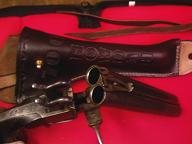

 The Accurate Reloading Forums
The Accurate Reloading Forums  THE ACCURATE RELOADING.COM FORUMS
THE ACCURATE RELOADING.COM FORUMS  Guns, Politics, Gunsmithing & Reloading
Guns, Politics, Gunsmithing & Reloading  Gunsmithing
Gunsmithing  Antique gun, fix or not?
Antique gun, fix or not?Go  | New  | Find  | Notify  | Tools  | Reply  |  |
one of us |
Hi all, I picked up an antique Blegian 45cal double pistol. The grip has a piece split off on the top next to the tang. I'm wondering if I should try and match a piece of wood to it then glue it on with small dowels and shape or just leave it alone. I took some pics, but the site where I put them seems to be down. Thoughts?  I'll see if this works. | ||
|
| one of us |
Leave it alone, that crack represents a part of that guns history whatever that might have been. You'd devalue it by attempting a fix. | |||
|
one of us |
It looks like the trigger and hammer sear surfaces are worn way down. Any thoughts on welding them up and recutting?  I'm thinking some copper coated steel brazeing rod to build the surfaces up, then recut and harden afterwards??? The extractor is missing, but shouldn't be too much trouble to make a new one. | |||
|
| new member |
It's your gun, you can do whatever you like with it. If it were mine I would glue in a matching piece of wood where the stock is broken and build an extractor for it. I'm not interested in any guns that I can't shoot, at least once. Be prepared to meet the wise men who say,"I would buy that for many $$ if only you hadn't restored it to shooting condition." If you don't repair it the same wise guys will say,"I would pay many $$ for it if the stock didn't have a part missing." Either way you lose. jcstead@telus.net | |||
|
| one of us |
I'd probably do the repairs on that one were I gonna keep it, if for no other reason that it would bother me having a broken piece laying about. Find somebody good with a TIG welder to build up the worn parts. As to the wood, I wrote this a while back for somebody else, but it generally applies....the only difference being I'd like to have a piece of wood the same age and species as the antique....Dixie Gunworks used to sell old European military stocks just for this purpose, so check with them....and I save all stock scraps from antiques just for that purpose, and probably have a chunk of 1870-vintage walnut laying around if you need it: Quote: | |||
|
| one of us |
I 've got one of those too. Mine looks pretty cheesie. I would not expect a repair to be lasting. I also would not trust mine with live ammo. The engineering and seems pretty substandard. My extractor plunger is busted in half. The design of the plunger weakened the main shaft too much. The firing pins are tiny little things, pointed right at your eye. My lock up is very loose. I would bet the frame is soft iron. If I set everythig right it would not stay that way. I will keep mine as a curiosty, shooting it seems to be a unsafe at best. | |||
|
one of us |
I do intend to shoot this. I already have a box of 45 colt cases cut to .93". I slugged the barrel and it came out at .451" so I will load with a 230gn flatnose 45 acp bullet. The twist is 1:16. It has Nitro proof marks on the underside of the barrels. I was initially thinking of useing FFFg only, but may try some 2400 and keep the pressures at or under 10k per quickload. Any parts that I have to replace, I'll keep to go along with the gun. Maybe a new grip would be the way to go and just put this one up. I already drilled the screw holes and put hardwood dowels in to be able to hold the screws. I don't think this would detract from it as it isn't visible and really needed to be done. The fireing pins still have a sharp sholder on them to fit inside the nipples so I don't think I'll worry about that as pressures will be way low. I'm thinking that any new screws that I have to make will get a Plum brown treatment to more closely match the Patina. I think the gun will be shootable with the broken stock, but may look nicer with a new one. The broken grip wasn't shown in the Auction photos or in the discription, so I've emailed the seller. I"ll keep the gun, but I seems that it was intentially hid. | |||
|
| Powered by Social Strata |
| Please Wait. Your request is being processed... |
|

Visit our on-line store for AR Memorabilia

